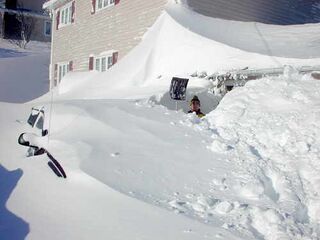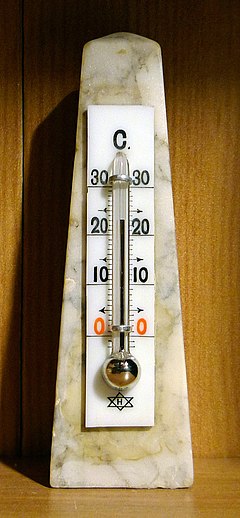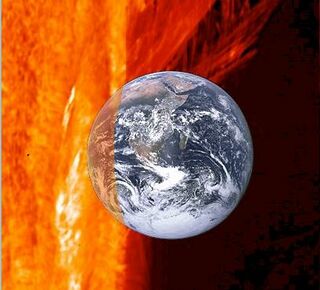Fake temperature
In meteorology and psychology, fake temperature (a.k.a. "feels like X degrees") is a mathematical adjustment made to a real physical temperature by applying the general principles of economic inflation to thermodynamics. As any competent scientist knows, objective facts are important in and of themselves. And, as any competent psychologist knows, subjective feelings are a good deal more important than objective facts. By dictating to people how they are supposed to feel about something, as opposed to asking them about it for a change, it is hoped that our younger generations will be more easily persuaded into believing whatever we want them to believe instead of what they want themselves to believe.
Discovery and subsequent confirmation of fake temperature[edit | edit source]
The concept of fake temperature was discovered in 1977 by a previously unknown celebrity by the name of Carl Sagan, who wanted to alert the general population to the inherent dangers of not taking both global warming and nuclear winter seriously. Prior to this discovery, nobody cared about either global warming or nuclear winter. In fact, it took an additional ten (10) years for Sagan himself to be convinced.
Sagan eventually decided to rigorously "test" his non-scientific and untested theory on a random sampling of unsuspecting people trapped within a tightly-controlled environment (i.e., temperature, pressure, and gravity all held constant). The results were astonishing: 44.3% of the population were tricked into believing that it was too hot. Another 43.7% were tricked into believing that it was too cold. A further 0.2% firmly believed, against all attempts to persuade them to the contrary, that the temperature was just right[1]. The remaining 11.8% were tricked into believing that they would actually get paid for their participation in the survey, and were subsequently discarded en masse as "experimental error".
After winning his first two Ignobel Prizes for (1) his discovery of fake temperature and (2) his subsequent confirmation of the same, Sagan went on to win an unprecedented third Ignobel for "Crafting an Exceedingly Complex Mathematical Formula which Nobody Understands but Works Anyway". It was this exceedingly complex mathematical formula that laid the groundwork for constructing actual real-world thermometers that could trick almost anybody into believing all kinds of stuff. Unfortunately, the full mathematical formula in question is much too complex to go through the laborious and unpleasant task of encoding it into LaTeX in order to properly display it in this here article. Besides, it was lost to posterity in a tragic hard-disk failure last week, lucky us. Fortunately, Sagan left in the margins of his copious hand-written notes a simplified approximation which is close enough for most simple people.
Introduction to the Fake Temperature Scale (FTS)[edit | edit source]
The fake temperature scale (a.k.a. the "feels-like" scale) purports to modify any real outdoors temperature a typical human may be inadvertently exposed to by multiplying the difference between the actual temperature and the ideal human comfort temperature[2] by a constant psychological factor of 1.5[3]. This process of dilating[4] the standard temperature scale simultaneously takes into account the typical relative stupidity humidity during summertime and the typical wind-speed during wintertime, and collapses everything into a single easy-to-understand number better suited to the purpose of scaring unsuspecting people with sensationalistic headlines.
HowTo:Convert real temperature to fake temperature[edit | edit source]
To convert real temperature to fake temperature, purchase and arrange two thermometers side-by-side: one calibrated to real temperatures, and the other calibrated to fake temperatures. If, instead, the appropriate thermometers are completely unavailable for some reason, just follow this handy-dandy real-to-fake temperature conversion guide:
REAL-TO-FAKE TEMPERATURE CONVERSION GUIDE To find: Use this handy-dandy formula: Fake Fahrenheit °Ffake = (1.5 x °Freal) - 30 Fake Celsius °Cfake = (1.5 x °Creal) - 8 Fake Kelvin °Kfake = (1.5 x °Kreal) - 145
Note that this simplistic conversion works only on outdoor temperatures, since (a) the typical wind-speed inside a properly maintained residence is, by definition, 0 MPH (0 KPH), and (b) if the indoor thermostat is set to just right, nobody gives a flying farck about how humid it is anyway.
A typical real-world application[edit | edit source]
For example, the real temperature of the surface of the Sun is about 9930 °F (5499 °C, or 5772 °K). To a typical astronaut who doesn't take the proper precautions while strolling on the surface of the sun, it would "feel like" 14865 °F (8241 °C, or 8513 °K). This makes walking barefoot on the solar photosphere, which is not a terribly bright idea in the first place, seem like a good deal more dangerous than it actually is.
HowTo:Convert fake temperature to real temperature[edit | edit source]
To convert fake temperature to real temperature, just reverse the goddamn process.
WARNING[edit | edit source]
WARNING DANGER DANGER WARNING: Be extra careful not to confuse a fake temperature for a real one, because mistakenly applying the conversion two or more times in a row leads to truly super-scary results, and we're not quite ready for that. Yet.
Footnotes[edit | edit source]
- ↑ This astonishing result was later named the "Goldilocks Effect", after the real-life heroine of an obscure German folktale.
- ↑ The ideal human comfort temperature is an extraordinarily difficult thing to pin down with any rigid certainty. For example, if a sexually-aroused person says something to the effect of "I feel so incredibly hot right now!!!", many other people inside the same room may mistakenly interpret it as a polite request to turn the heat down.
- ↑ In the future, this constant fudge factor may need to be adjusted upwards via legislative action in order to account for people becoming psychologically desensitized from excessive exposure to artificially inflated numbers.
- ↑ Or compressing, whichever works best.



